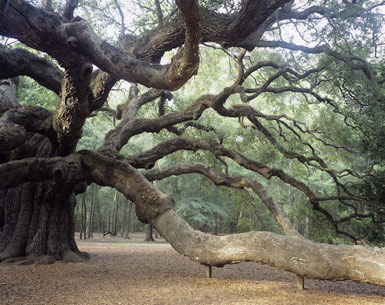
- A Society of Royal Oaks -
Angel Southern Live Oak Tree
Angel Oak Park, Johns Island
Charleston, South Carolina

Founded in 1670, Charleston is steeped in American history and regional culture.
The Angel Oak, a giant among southern live oaks (Quercus virginiana), has seen native Carolinians, enslaved Africans, and white planters passing under its boughs. That is, it has stood over tangled forests where native Kiawah Indians hunted and fished; has witnessed the agony of African people enslaved and brought unwillingly to this land; and watched the hopes and dreams of Europeans beginning a new life in a paradise rich in flora and fauna.
Under the leadership of Charleston Mayor Joseph P. Riley Jr., the city purchased the tree and surrounding five acres of land in 1988. Angel Oak Park was thereby created and opened by the City of Charleston in 1991. Today, the Angel Oak stands 65 feet tall and has a circumference of 25½ feet at breast height. The island site of the Angel Oak is undergoing profound changes, with pressure from development interests and the rapid growth of the resort islands of Kiawah and Seabrook. The Angel Oak has withstood centuries of nature’s furies, but must be protected from the human impacts that threaten its continuing health. Only in doing so, can we assure that this massive specimen, known for its strength and sweeping delicacy, may continue to link the centuries.